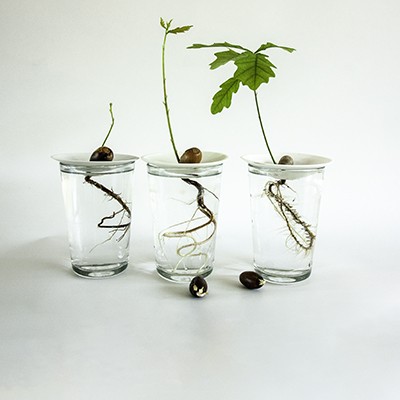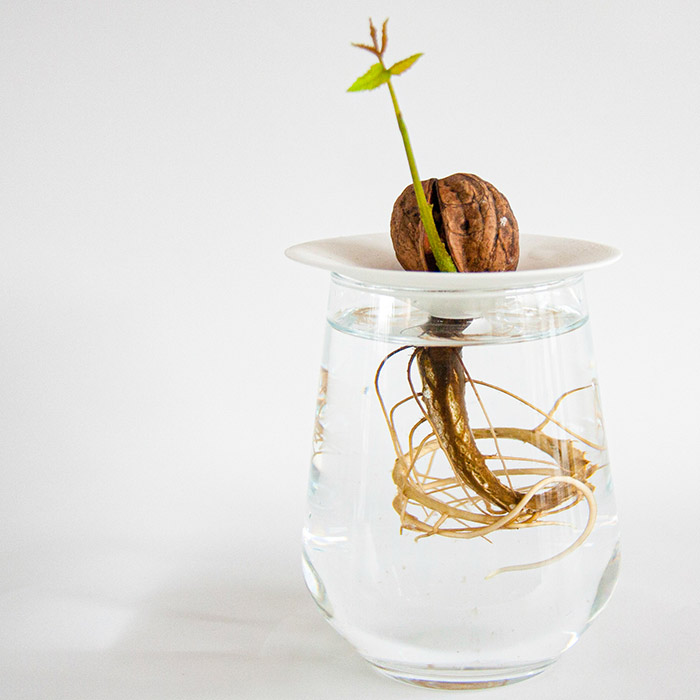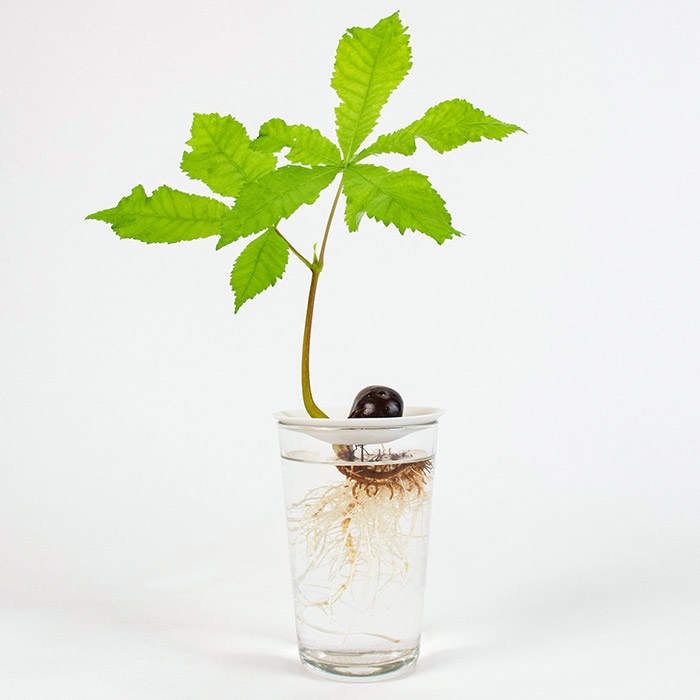Your guide to collecting acorns, nuts and tree seeds in the fall, to grow into tiny trees.
Cripsy fall leaves, pumpkin everything, and taking your favorite sweaters out of the closet again… Who doesn’t love fall?
Nature also has a lof of treasures to offer in autumn, that we’re particularly fond of here at Botanopia. Believe it or ‘nut’, October is hoarding season for us! All around us, trees are releasing their seeds, fruits and nuts. From acorns to walnuts, chestnuts and hazelnuts, but also more exotic seeds such as gingko nuts, it’s harvest time. We’ll show you what to look for in the trees around you, and what to do with your bounty, so you can grow tiny floating trees at home.
So put on your rain boots, pack a bottle of hot tea and go nut-hunting (after reading this guide of course 😋 )
Acorns
Did you know that there are around 600 species of oak that produce acorns? Each variety has specific properties such as she shape of the leaves, but also the size, shape and color of the acorns themselves.
When can they be harvested?
Here in Amsterdam, the main harvesting season of acorns is between September and October. That’s when the acorns naturally fall on the ground and you can collect them before they get eaten by insects and animals.
However, with a little luck, a few acorns can still be found in the spring under the leaf cover. These overwinter on the ground and are kept fresh by the cold. If you’re lucky, they’ll have started germinating already after spending the winter outside.
No need to climb up the trees, we just wait for the acorns to hit the ground.
The color doesn’t really matter, most acorns start out green, and mature to a brown color. Select acorns without holes in their outside shell, that’s a sign of insect invasion… It doesn’t mean your acorn won’t germinate at all, but you might get little worms and bugs crawling out after a while…
We show you how to proceed to germinate and trick them into a “winter holiday” in this video.
Floating forest
This is what your acorn will look like after germination. If you start in September/early October, you can time these to be ready around the Christmas holidays, to add a pretty touch of green to your holiday decor. Pssst, they make an original gift too, don’t you think?
To transform the tiny acorn into an oak tree, check out our guide with a video tutorial on how to germinate an acorn.

Walnuts
Walnuts are a tasty snack, but they also make a beautiful little plant. The same info applies to other hazelnuts as well.
When can they be harvested?
Walnuts can be harvested at the end of summer to mid-autumn, so from around early September to early November. The flesh inside should be fresh, not yet dried out, for your best shot at germinating them. If you crack one open, you’ll see the flesh is plump and white, and the taste very mild, compared to (dried) supermarket walnuts. Some greengrocers also sell fresh walnuts when in season, if you don’t feel like hunting for a walnut tree.
You’ll know that your walnut is ripe for plucking when the green outside husk starts to split or turn brown. Be careful, the brown husks contain a very powerful stain, that will turn your skin dark brown for days. Wear gloves when handling fresh walnuts!
Do you want to germinate them?
To grow walnuts into plants, you’ll need to use fresh walnuts. The ones you can buy at the supermarket are usually already long dried and won’t germinate. Compared to the other nuts, the success rate of walnuts is quite low, so patience and persistence is required. Start with more than you think you need, to higher your chances of success.
But that’s no reason to back up! They make beautiful little plants for your home, so why don’t you pack a few on your next stroll through the woods.
We created a tutorial for you with everything you need to know about germinating walnuts. Just click here and let the fun begin.

Chestnuts
They are two distinct types of chestnuts, coming from very different trees : horse chestnuts (also called conkers) and sweet chestnuts. Only the sweet chestnuts are suitable for human consumption, so tasty once roasted on an open fire. For our purpose of growing them into little trees, both types work in the same way though.
When can they be harvested?
The nuts from the chestnut tree can usually be harvested between the beginning and middle of autumn.
With chestnuts, you have to deal with a spiky husk. Wear shoes with a thick sole, so you can gently step on the husks to split them open, and get to the chestnuts without pricking your fingers. You can also wear thick gloves to handle them.
Do you want to germinate them?
How about growing yourself a little chestnut tree? Both horse chestnuts and sweet chestnuts grow in the same way.
Just have a look at our short tutorial and see if it could be something for you. We provide you with tips and step-by-step instructions, to help make your little project a success. You’ll find our tutorial here.

What to keep in mind
There are just a few little things you should remember in general when harvesting your nuts.
– Check for signs of immature seeds/nuts : if the seed is very light, compared to other seeds of the same size, it’s a sign that’s it’s immature, or that insects have already made their lunch out of the seed. Avoid seeds with visible holes or cracks.
– Be respectful of nature. Don’t cut the branches and try not to damage the tree in any way.
– If you plan on germinating, then don’t put your hopes into one nut. Collect multiple ones and multiple species, so you have more chance of success. All you need to know about germination and what to keep in mind, you’ll find here.
-Helpful tool to keep your seeds dry, while the roots grow in the water : Germination plates! they come with 2 different sizes of holes, depending on the size of your seeds. Size S is best voor smaller seeds such as acorns and hazelnuts, and Size L for the bigger seeds like Walnuts or horse chestnuts (and avocado pits).
